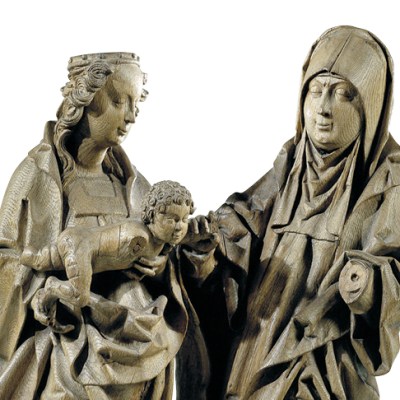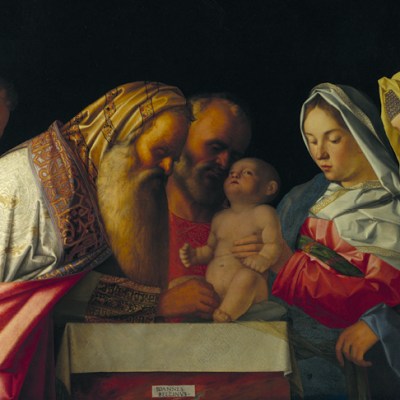Andrea del Verrocchio (c. 1435–88) was one of the most original, inventive and multi-talented of Renaissance artists, yet he remains little known by the general public. Even when he is discussed, it is always in the shadow of his greatest associate and student, Leonardo da Vinci. The cuckoo in the nest, Leonardo outgrew his master, and so far outgrew his fellow fledglings that their common origin has, for many, been lost. This exhibition, mounted at the Palazzo Strozzi in Florence 500 years after Leonardo’s death, seeks to redress the imbalance and, despite a title maintaining the status quo, it succeeds in identifying Verrocchio as the single most influential artist in Florence in the second half of the 15th century.
Verrocchio was the son of Michele di Francesco Cioni, described as a fornaciaio, a man who used a kiln: he might have been a brickmaker, or involved in the production of ceramics. However, the artist almost certainly took his name from one of the two goldsmiths with whom he trained, Francesco di Luca Verrocchio. In his tax declaration of 1457 Andrea stated that, as there was not enough work as a goldsmith, he had effectively moved on. Precisely how he learned to paint is not clear, but the exhibition outlines his training as a sculptor with succinct clarity. We are presented with three female portrait busts, the first by Desiderio da Settignano, the second a tentative work in a similar style by the young Verrocchio, and finally the latter’s mature and assured Bust of a Lady (Lady with Flowers). Here the delicate depiction of detail and subtle exploration of asymmetry (typical of Verrocchio) leave you assured that we are in the hands of a master. The three-quarter length sculpture, with arms and hands included, is echoed by a fourth exhibit, Leonardo’s drawing A Study of a Woman’s Hands, which has regularly been linked both to Verrocchio’s sculpture and to Leonardo’s Portrait of Ginevra de’ Benci. The line of argument is clear: Desiderio taught Verrocchio to carve, and the latter handed the baton of creativity to Leonardo.
A Study of a Woman’s Hands (c. 1490), Leonardo da Vinci. Royal Collection Trust; © Her Majesty Queen Elizabeth II 2019

We are welcomed to the second room by the relaxed gaze of Verrocchio’s bronze David, perfectly angled to watch over us as we enter, yet with his body twisted to face the room. The placing of works in this exhibition is superb, and here demonstrates Verrocchio’s developing mastery of space. Again there are drawings by Leonardo acknowledging his debt to the master: a double-sided sheet of multiple studies, including repetitions of the profile of the David. The sculpture illustrates how necessity became triumph: within a decade of unemployment as a goldsmith, Verrocchio was established as the chief sculptor of his day. Not only that: this was a Medici commission. He may have worked with Donatello even before learning marble carving from Desiderio, and certainly took over the older master’s role as principal sculptor to the Medici. He continued in this unofficial position for around 15 years, until he visited Venice in 1483 to complete the bronze equestrian sculpture of Bartolomeo Colleoni, a project that would occupy him until his death five years later.
Verrocchio’s paintings and sculptures are often studied as if they are products of separate workshops, but here, as far as is possible, they are brought together. A painting from Berlin, showing the Madonna with the Christ Child standing, is displayed opposite the Bargello’s terracotta relief of the same subject. The two works are presented as archetypal images, and are flanked by numerous echoes of the composition by Verrocchio’s disciples, painters and sculptors alike. Comparisons between media also link one room to another. For example, the exploration of fictive space and movement in Tobias and the Angel becomes more fascinating when seen in relation to the bronze Winged Boy with Dolphin, beautifully restored and exhibited a few rooms further on.
Tobias and the Angel (c. 1470–75), Andrea del Verrocchio. © National Gallery, London

Among the many treasures, much attention has been focused on the V&A’s terracotta Madonna with the Laughing Child, here taking up the attribution to Leonardo first proposed in 1899. We know Leonardo worked in sculpture from his own accounts and from the reports of others, and the search for these elusive pieces has been extensive. This attribution certainly deserves serious attention, and I look forward to a more thorough argument. However, despite some similarities with one of the exhibited drapery studies, I remain unconvinced, as other drawings by Leonardo in the exhibition show a very different drapery style. The catalogue entry for the sculpture is, of course, more thorough than the exhibition can allow. Reference is made to drawings by Verrocchio and his followers, which would bring the work into the sphere of the master, but sadly these have not been reproduced, and while the relationship between mother and child is indeed similar to Leonardo’s youthful drawings of the Virgin and Child with a cat, the sketchy nature of these studies makes direct comparison inadvisable.
The previous attribution, and one I still favour, is to Antonio Rossellino. There are numerous formal similarities with the sculptures of the Cardinal of Portugal’s chapel, presumably executed to Rossellino’s designs even if not by Rossellino himself, and there are also several specific connections with a little-known product of the Rossellino workshop, the tomb of Francesco Sacrati. Carved for the church of San Domenico in Ferrara in the early 1460s, the tomb was later broken up and the surviving sculptures dispersed. The Madonna and Child, which would have been the central element of the tomb, is a high relief of the same size and proportions as the Madonna with the Laughing Child, and I have long wondered if the terracotta is in any way connected to the tomb project. A figure of St Dominic, which would have flanked the Madonna, is carved in a similar style to the terracotta, with complex, deeply carved, layered drapery, flattened with angular folds, and has the long, spidery fingers of the V&A Madonna.
This superb sculpture undoubtedly deserves its place in the limelight, but inevitably this comes at a cost to Verrocchio. The exhibition succeeds in establishing both his origins and his originality as a sculptor, his brilliance as a painter, and his influence in both fields. It also brings together the ‘School of Verrocchio’, including the team of skilled artists (notably Lorenzo di Credi and Francesco di Simone Ferrucci) who executed commissions when the workload increased. And yet, with the re-proposed attribution for the Madonna with the Laughing Child, Leonardo continues to cast a long shadow.
‘Verrocchio, Master of Leonardo’ is at the Palazzo Strozzi, Florence until 14 July.
From the May 2019 issue of Apollo. Preview and subscribe here.



